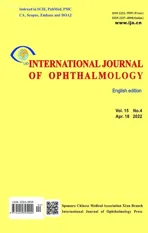Efficacy of conbercept after switching from bevacizumab/ranibizumab in eyes of macular edema secondary to central retinal vein occlusion
2022-04-19TongZhaoYouChenHongSongZhangYiChenZhiJunWang
INTRODUCTION
Macular edema (ME) secondary to central retinal vein occlusion (CRVO) is a common cause of vision loss. Vascular endothelial growth factor (VEGF) has been demonstrated to play an important role in the hypoxia course after the occlusion of the retinal vein. Numerous studies have proved that anti-VEGF agents, including bevacizumab,ranibizumab, and aflibercept, are basically safe and effective.Similar to aflibercept, conbercept (Lumitin; Chengdu Kang Hong Biotech Co., Ltd., Sichuan Province, China) is a fusion protein composed of the extracellular domain 2 of VEGF receptor 1 and extracellular domains 3 and 4 of VEGF receptor 2 combined with the Fc portion of the human immunoglobulin G1. Prior studies indicated that conbercept showed favorable safety and efficacy in the treatment of ME secondary to retinal vein occlusion. In real clinical practice, some cases trend to respond insufficiently to anti-VEGF injections or to rebound repeatedly. Although switching strategy is very common,little attention has been paid to the switching to conbercept.
Images of SCP and DCP were exported and analyzed with Image J software (1.8.0_112, http://imagej.nih.gov/ij/; National Institutes of Health, Bethesda, Maryland, USA) to acquire perfusion density (PD) and vascular length density (VLD).We calculated the parafoveal vessel densities for the SCP and DCP. The parafoveal region was set to be an annulus centeredon the fovea with inner and outer ring of diameters of 1 and 3 mm, respectively. PD was the percentage of pixels occupied by blood vessels in the binary image of the grayscale OCTA image. VLD was defined as the ratio of skeletonized vessel length to the total area. Images were imported to Image J and binarized to assign each pixel to be either “perfused” or“background”. PD was calculated from the binarized images with a vascular density plugin application. After binarizing, a skeletonized slab was created, representing vessels one pixel in width, and VLD was calculated with “Analyze Skeleton”mode in Image J.
Optical coherence tomography angiography (OCTA) is a new,noninvasive technology that provides detailed information about the retinal microvasculature with the measurements of vessel density and foveal avascular zone. The evaluation of macular perfusion makes it possible to know more about the change after intravitreal injection of anti-VEGF agents.In this study, we quantified retinal vessel density of both superficial and deep layer of retina to evaluate the change of retinal vasculature and macular thickness after switching from bevacizumab and/or ranibizumab to conbercept.
SUBJECTS AND METHODS
本文在对新课程背景下小学语文课堂教学中的合作学习进行研究时,注重的是如何提升小学语文课堂教学中合作学习模式的应用效果,这需要结合小学生的年龄特点、小学语文的教学目标、合作学习的具体方式等等来进行改进,并在这一过程中要融入新时期的教育理念,体现现代化教育观,这样才能保证合作学习的实效性和价值性。下面笔者结合实践经验以及相关方面的理论基础,对此进行详细论述。
From March 2016 to December 2018,medical records of cases of ME due to CRVO were retrospectively reviewed.
Including criteria: 1) Patients aged 18 years or older with diagnosed CRVO and confirmed ME through optical coherence tomography (OCT) scan; 2) Prior treatment with a minimum of three consecutive intravitreal injections of either bevacizumab(1.25 mg/0.05 mL) or ranibizumab (0.5 mg/0.05 mL); 3)Switching to conbercept (0.5 mg/0.05 mL) due to refractory ME, which was defined as persistent ME or recurrent ME that initially resolved after treatment with bevacizumab and/or ranibizumab but did not respond to following repeated injections; 4) Following conbercept injection using a(PRN) regimen; 5) With a follow-up period of at least 12mo after switching; 6) OCTA was performed before switching and in the twelfth month after switching.
Excluding criteria: 1) Eyes of primary or neovascular glaucoma and initial intraocular pressure (IOP) exceeded 21 mm Hg; 2)Vitrectomized eyes; 3) The presence of active confounding retinal or ocular disease (, severe diabetic retinopathy,exudative macular degeneration, macular hole,).
关于感性认识与理性认识之间的层次关系问题,王船山认为“由知而知所行”“并进有功”,也就是理性认识只有在实践当中才能指导社会生活实践,知行相辅相成就能取得事半功倍的效果。毛泽东不仅认可社会实践是检验真理的唯一标准,也同时指出了“认识”对社会实践的巨大反作用。“通过实践而发现真理,又通过实践而证实真理和发展真理。从感性认识而能动地发展到理性认识,又从理性认识而能动指导革命实践,改造主观世界和改造客观世界。”[8]在学习的方式、方法上,毛泽东也强调理论联系实际,在学习态度上要谦虚,要“甘当小学生”“来不得半点虚伪和骄傲”,这一观念也同王船山的“不自圣”“不自倨”的学习态度是一脉相承的。
Over the follow-up period, no progression of diabetic retinopathy was observed in the two patients of mild non-proliferative diabetic retinopathy. Progression of posterior subcapsular cataract was found in one eye of the 20 phakic eyes during the follow-up after switching; the fellow eye had the similar progression of cataract and both eyes underwent cataract extraction and lens implantation.
This was a retrospective study that was approved by China-Japan Friendship Hospital Ethics Committee and adhered to the Declarations of Helsinki.Informed consent was obtained from all patients who were enrolled in the study.
Six eyes (25%) received only ranibizumab(9-15 injections) previously while 15 eyes (62.5%) received only bevacizumab (8-20 injections) and 3 eyes (12.5%)received injections of both, two of which were switched from bevacizumab to ranibizumab (5 and 3 injections for one subject; 4 and 4 injections for another) and one of which was switched inversely (6 and 4 injections). The number of injections ranged from 8 to 20. The mean number of injections was 14.3±5.7 within a mean follow-up duration of 16.1mo(12-29mo) and the mean interval between injections was 5.2±2.3wk.
据云南省发展改革委党组成员、主任助理梁琦介绍,截至目前,全省特色小镇新开工项目710个,累计完成投资633.2亿元,特色小镇实现新增就业6.5万人,新增税收8.6亿元,新入驻企业2576家,集聚国家级大师和国家级非遗传承人53人,特色小镇共接待游客人数1.8亿人次,其中过夜游客5832万人,实现旅游收入1052亿元。
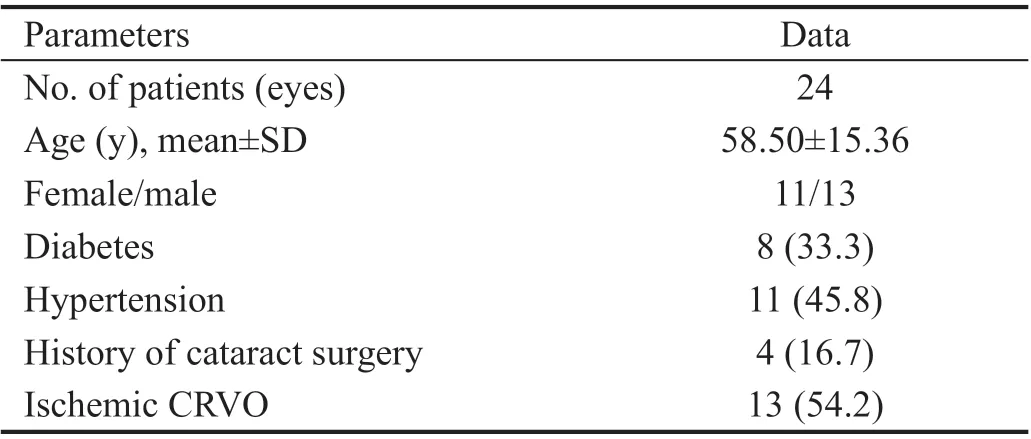
As far as we know, this was the first study that evaluated the efficacy of switching to conbercept in refractory ME secondary to CRVO. In our study, significant improvement of CRT and BCVA was observed in the first month after switching to conbercept and the injection interval increased significantly in the follow-up period. The superior efficacy of conbercept comes from the high affinity to VEGF. As a fusion protein, conbercept also bonds to VEGF-A, VEGF-B and PIGF. Compared with aflibercept, conbercept contains one additional binding domain of VEGF receptor 2 which enhances the affinity. Based on our findings and previous study, we believed conbercept could be a secondary therapy for refractory ME in CRVO eyes with prior treatment of bevacizumab and/or ranibizumab.
RESULTS
We initially included 29 eyes of 29 patients. Segmentation errors were found in all OCTA images and manual correction were used. But 5 of them were excluded due to low-quality images with obvious motion artifacts and signal loss which made even manual segmentation impossible.Finally, twenty-four eyes of 24 patients were included in the study. Eleven (45.8%) were male and 13 (54.2%) were female.The mean age was 58.50±15.36 years old (ranging from 24 to 71). Eight of the patients were diagnosed as diabetes and two of them had mild non-proliferative diabetic retinopathy. Eleven of the patients had hypertension. Four eyes had a history of cataract extraction and intraocular lens implantation and the other 20 eyes were phakic. Thirteen of the included eyes were ischemic CRVO and had received laser treatment. None of the fellow eyes were diagnosed as CRVO or ME (Table 1).
All recruited subjects underwent OCTA scan with a swept-source OCT (Triton DRIOCT, Topcon, Inc., Tokyo, Japan). Raster-pattern retinal scans were obtained through the macula using scanning patterns of 6×6 mmin all patients. Images with a quality score below 40 were excluded. We also excluded low-quality images with obvious motion artifacts, signal loss. The built-in software(IMAGEnet6, v1.23.15008, Basic License 10) was used to identify superficial capillary plexus (SCP) and deep capillary plexus (DCP). The SCP was set at 2.6 μm below the internal limiting membrane, and the outer boundary at 15.6 μm below the junction between inner plexiform and inner nuclear layer(IPL/INL). The DCP started at 15.6 μm below IPL/INL, with the outer boundary at 70.2 μm below IPL/INL. Automated segmentation of macular thickness was manually corrected.Images which were difficult to segment were also excluded.
After switching to conbercept, the mean follow-up duration was 13.8 (12-16)mo. The number of injections decreased to 8.1±5.5 (4-10), which was statistically significant (=0.008) compared with before switching. The mean injection interval increased to 8.3±3.9wk correspondingly (=0.012).
The mean BCVA (logMAR) at baseline was 1.06±0.48 and before switching to conbercept 0.98±0.33 (no significantly improved compared to baseline,=0.469). It changed to 0.72±0.35 in one month after the first injection of conbercept (=0.005 compared with baseline,=0.032 compared with before switching) and 0.76±0.42 at the end of follow-up (=0.012 compared with baseline,=0.070 compared with before switching, and=0.733 compared with one month after switching; Figure 1). The average of CRT at baseline was 559.67±175.71 μm, before switching 460.71±153.23 μm (=0.005 compared with baseline), 1mo after switching 296.21±47.55 μm (<0.001 compared with baseline and<0.001 compared with before switching) and at the end of follow-up 283.92±38.27 (<0.001 compared with baseline,<0.001 compared with before switching,=0.725 compared with 1mo after switching; Figure 2). The IOPs at four visits were 14.85±3.89, 13.77±3.51, 14.16±4.04, and 14.52±3.78 mm Hg, with no significant differences (=0.704).
At the end of follow-up, PD of DCP decreased significantly to 33.26%±5.82% (=0.016)compared with before switching (34.62%±5.27%) and a significant decrease of VLD of DCP was also found (from 25.10±3.60 to 24.41±3.35 mm,=0.040). No significant change of VLD of SCP was observed at the last follow-up (16.75±1.72 mm)compared with before switching (16.94±2.01 mm,=0.667).Similar result was found in PD of SCP (from 32.52%±4.34%to 32.32%±3.46%,=0.846; Figure 3).
Demographic information, best-corrected visual acuity (BCVA,converted to logMAR), IOP, central retinal thickness (CRT),the interval between injections and the number of injections were reviewed and collected.
DISCUSSION
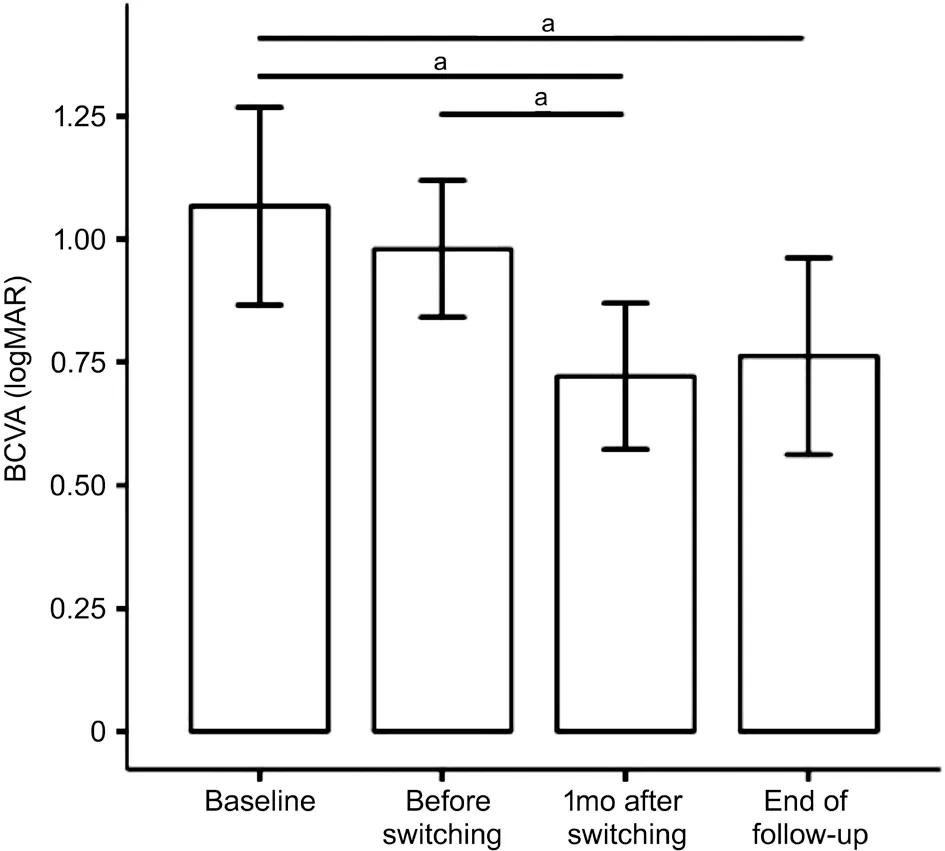
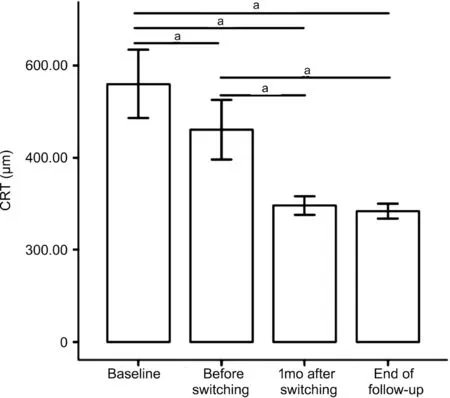
Anti-VEGF therapy has become the most commonly used treatment for ME secondary to CRVO. Numerous studies focused on the comparison about the efficacy of the anti-VEGF drugs. A randomized clinical trial indicated 1) that the vision gain after treatment of ME due to CRVO was no worse using aflibercept compared with ranibizumab; 2) bevacizumab might be not noninferior to aflibercept; 3) aflibercept group had fewer injections. Similarly, prior studies indicated that conbercept had the statistically same visual gains and safety as ranibizumab and had advantages over ranibizumab in terms of the number of injections for treating ME secondary to retinal vein occlusion. Based on the advantage of fusion proteins over antibodies, aflibercept was chosen to treat refractory cases that either did not respond to ranibizumab/bevacizumab or rebounded frequently. Eadiereported a six-eye case series of refractory CRVO responding favorably to aflibercept as a secondary therapy. Subsequently, several studies found that switching to aflibercept could stabilize vision, improve macular thickness and extend treatment intervals. It was believed that the molecular characteristics of the higher affinity of aflibercept to VEGF-A might contribute to the superior treatment effect. In addition, aflibercept bonded to not only VEGF-A but also VEGF-B and placental growth factor(PIGF). Besides, the tachyphylaxis after successive injection and the anti-bevacizumab/ranibizumab antibodies could serve as possible explanations of the previous recurrent ME.
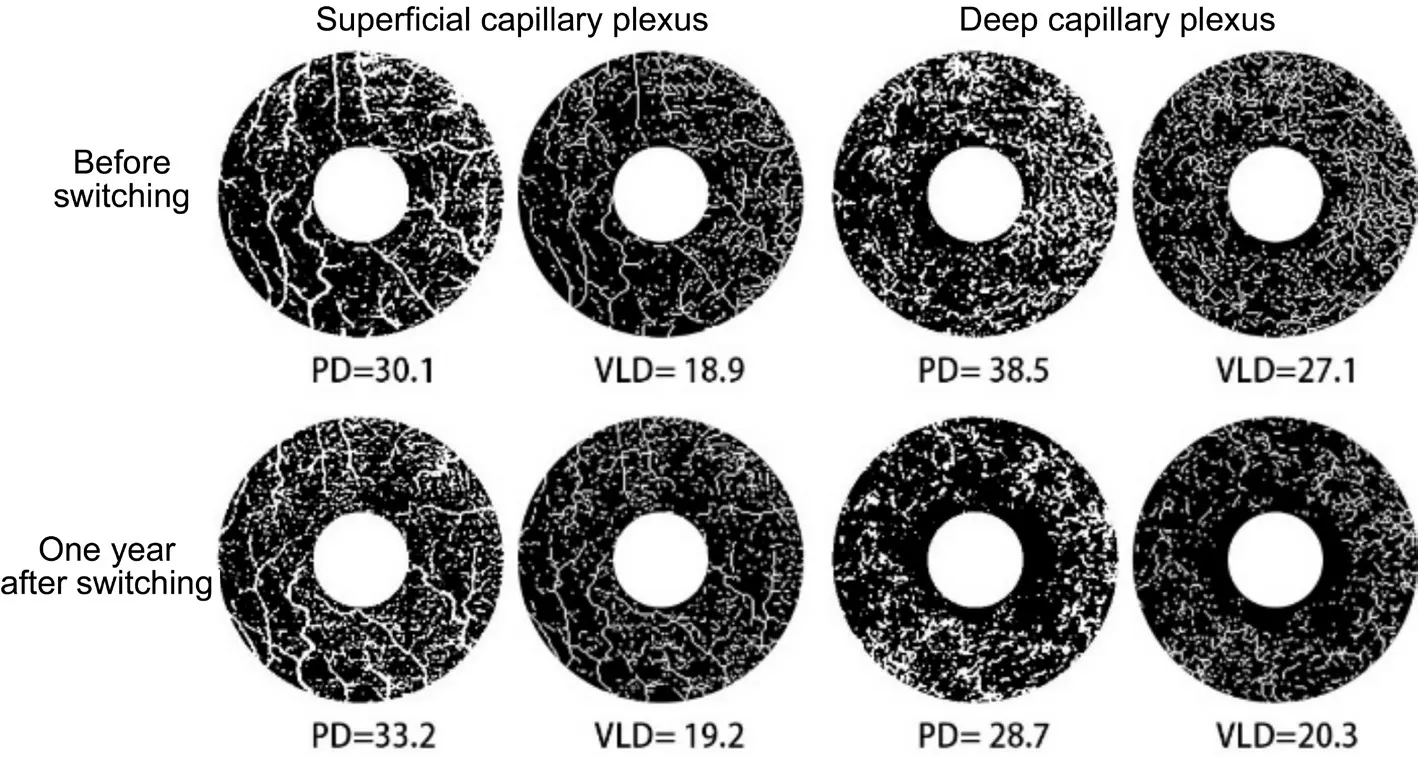
Statistical analysis was performed with SPSS 22.0 (IBM Corp., Armonk, NY, USA). Mean values with 1 standard deviation are recorded when data is normally distributed. Paired samples-tests were used to compare injections intervals and OCTA parameters before and after switching. One way analysis of variance and the LSD post hoc test were used to compared BCVA, CRT, and IOP. All tests were two-tailed, and thevalue<0.05 was defined as statistically significant.
近年来,在临床治疗中的输血量不断增加,输血安全问题也越来越受到重视[3]。输血科在患者临床输血的救治中承担着越来越重要的任务,不仅要提供理论上的咨询需求,还要在救治患者时及时并准确的给患者提供血液[4]。在对策实施的过程中,医院的医护人员对输血流程的畅通性有了更深刻的认识,同时也提高了大家输血风险的防范意识。改善后的调查统计中可喜的发现,缺陷率由原来的6.6%,降到了2.6%,改善的重点都达到了我们预期的目标。在整个临床输血的过程中,每个环节之间的连接也更加紧密[5]。PDCA循环是开展所有质量活动的科学方法,“雪圈”将用此方法不断持续的改进工作流程。
人老了的最大特征是变得啰嗦了。每次打电话,絮絮叨叨的总是那些事,刚说过的一句话,没过两分钟又重复一遍。上次我妈给我打电话,开头一句是:“要是不舒服你要记得去医院看看啊。”快挂电话时又补一句:“一定要去医院看看啊,楼下的那家健民药店有个老中医就挺好,早点去,免得排队。”
In our study, the BCVA improved significantly in the first month after switching compared with before switching, but the improved vision was not sustained until the end of followup although CRT maintained the same thickness. Impaired retinal microvasculature following the persistent or recurrent edema and might be the reason. In this study, we observed decreased vessel density in DCP in the end of follow period.Previous studies indicated that vessel density in both SCP and DCP decreased in eyes of CRVO compared with fellow eye and vessel density in DCP seemed to be impaired more significantly. The deep retinal layer had more abundant microvasculature and might be more susceptible than the superficial layer in the pathogenesis of CRVO. Moreover, ME occurred mainly in deep layer. Recurrent or persistent ME may lead to drop-out of capillaries of DCP and this deterioration was hard to be reverted with anti-VEGF treatment. Prior studies reported that anti-VEGF therapy could improve retinal ischemia in a short term, mainly manifested with improvement of vascular telangiectasia, dilation, and decreased non perfusion area. Some recent studies showed unchanged or improved vessel density after treatment of conbercept with the follow-up period of 1 to 6mo. Contradictorily,we observed decreased vessel density of DCP 12mo after use of conbercept. The variety could be result of different instruments, regions of interest, methods of calculating vessel density, and disease severity while the most likely reason may be different observation time. There exists the possibility that anti-VEGF therapy slows the progression of ischemia or even improves that within a short time but might not stop it in the long run. Our findings indicated that the ischemic damage of the deep retinal vessels may be progressive and nonreversible.There were some limitations of this study, including the retrospective nature of the study and lack of control, and the small sample size, varied anti-VEGF agents before switching added the biases of the study and lowered the strength. Besides,since the analysis based on OCTA was performed only on the annulus area centered on the fovea, the findings of the study could not extend throughout the entire retinal vasculature.Further prospective controlled studies are warranted.
In conclusion, switching to conbercept in eyes of refractory ME secondary to CRVO extended injection interval and improved macular anatomy while the vision improvement was not significant. Retinal microvasculature did not improve with treatment of conbercept.
4.3.3 可用25%扑虱灵2000倍液,或10%吡虫啉可湿性粉剂1000-1500倍液,每隔5-7d喷1次,连喷2-3次,也可用灭蚜灵烟剂,每次350g/667m2,交替使用。
(2)用水效率提高难度加大。随着三江平原等区域地表水灌溉逐步替代地下水灌溉,农田灌溉水有效利用系数难以持续提高,同时,灌区节水改造任务重、投入大、时间长、见效慢也是影响灌溉水有效利用系数进一步提高的重要原因。近两年,黑龙江省万元GDP用水量和万元工业增加值用水量逐年下降趋势明显(2016年度229 m3/万元,2017年度206 m3/万元;2016年度56 m3/万元,2017年度45.6 m3/万元),但是远高于国内先进地区。由于经济增长趋缓,有的地市甚至出现负增长,加之节水投入不足,部分地市万元GDP用水量和万元工业增加值用水量下降难度明显增大。
None;None;None;None;None.
猜你喜欢
杂志排行
International Journal of Ophthalmology的其它文章
- Comment on: Real-world outcomes of two-year Conbercept therapy for diabetic macular edema
- Efficacy of intravitreal conbercept combined with panretinal photocoagulation for severe nonproliferative diabetic retinopathy without macular edema
- lntraoperative complication rates in cataract surgery performed by resident trainees and staff surgeons in a tertiary eyecare center in Hungary
- Comparing surgical efficiencies between phacoemulsification systems: a single surgeon retrospective study of 2000 eyes
- Factors associated with corneal astigmatism change after ptosis surgery
- Outcomes of different lines of keratoconus management in a tertiary eye center in north China
